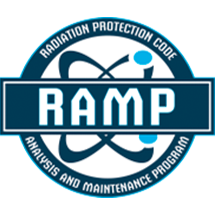We are about to attend a drill involving a Cold Shutdown accident. In this scenario the plant is in a refueling outage. Core alterations are taking place and primary containment is open. The plant has experienced an unplanned total loss of AC power which caused cooling to the reactor pressure vessel to be lost. Reactor coolant temperature is 210 degrees and rising. The RCS leaks into the drywell, initiating a SAE. The leak continues until the RPV level goes under the top of fuel for more than 30 minutes. How would I use RASCAL for this type of scenario. There is never going to be an actual release, but I would like to get our dose assessors running "What-ifs" in this scenario, so we can be familiar with this type of accident.

Re: Cold Shutdown in RASCAL
Based on internal discussions with some NRC dose assessors, here are some thoughts to consider in trying to model the scenario you raised. As with most accident scenarios, there is more than one method that may work to attempt to model it. The plant does lose AC power but it sounds as if you also have a leak in the RCS. If so, since you will likely have the time of core uncovery, it’s probably more correct to use the LOCA model rather than the LTSBO model. Additionally, the assumptions of 6-hour boil-off time in the LTSBO model may not be as applicable in cold shutdown vice power operations. The LOCA model you select will require three parameters: shutdown time (which you can set as the time the reactor was last at 100% power (potentially several days ago in this case), core uncovery time (which you can set as the time the RPV level goes under the top of fuel), and core recovery time (if the scenario defines when that RPV level was returned above fuel). The release path settings will largely depend on the defined scenario, but in this case, it could release through the dry well wall or through the suppression pool. In this case, it sounds like the primary containment is open, and therefore the “though the dry well wall” option would be more appropriate. Hopefully this will get you started with your what-if scenarios. If any of this information can be clarified, please let us know.
Cold Shutdown in RASCAL
Thanks, Jeff. This is probably a dumb question, but I am not sure what "primary containment is open" means in the context of a normal Cold Shutdown. Does this mean the Primary Containment is open to the environment, so that it would be something like 100% failure, or does it mean it is open in some way towards the RCS/Drywell/Suppression Pool, so that the primary containment still has the design basis leak rate intact?
Cased closed
Figured out the rest of the stuff, release pathway, yesterday during drill. It was a "hole" in primary containment because the hatch was open, which was 16ft diameter. Thanks for help